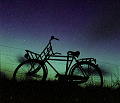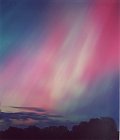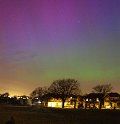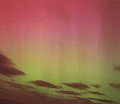|
Summary: A pair of coronal mass
ejections (CMEs) hit Earth's magnetosphere
on April 11th, triggering a severe G4-category geomagnetic storm that
lasted from 1500 UT to 1800 UT (11a.m. and 2p.m. EDT). Activity
subsided a little after that, but a strong geostorm continued
well into the next day and spawned impressive high-latitude auroras.
The CMEs were hurled into space by a pair of explosions: an M8-class
flare on April 9th followed by a X2-class flare on April 10th
-- both from sunspot group 9415. The April 10th CME was a fast-moving cloud
that caught its
predecessor
on the way to Earth, resulting perhaps in a cannibalistic
combination
of the two.
Unless
otherwise stated, all images are copyrighted by the photographers.
|
|
Photographer, Location |
Images |
Comments |
 |
Thad V'Soske,
Anza-Borrego Desert State Park, southern California |
#1 |
This photo is remarkable because of its southern
latitude, only 19 km north of the California-Mexico border. Photo
details: Fuji Superia 800, 4 min (2 flashes), Zuiko 21mm f/2
@ f/2.8 April 11, 2001 |
 |
Jan
Lameer, Terschelling, The Netherlands |
#1,
#2, #3,
#4 |
J. Lameer: "I use the bicycle for transporting
my photo equipment to dark locations in the woods. It is 40 years
old and was formerly used by a baker to bring bread around."
Photo details: Kodak Portra 800 film with exposures between 20
and 40 secs. April 11-12, 2001 |
 |
Garth Arsenault,
Prince Edward Island, Canada |
#1,
#2, #3,
#4, #5,
#6, more |
G. Arsenault: "Great show last night! The bridge is the Confederation
Bridge which spans 13 kilometers connecting Prince Edward Island
and New Brunswick, Canada. It is the longest bridge over ice
covered waters in the world." April 11, 2001 |
 |
Chris
Grohusko, near the border dividing New Mexico and Texas,
USA |
#1,
#2, #3,
#4, #5,
#6, #7,
#8 |
Photo details: Fujichrome Professional Provia
400 ASA, Pentax K1000 camera with 28mm at f/2.8 on B setting.
Exposure times for most shots ranged from 30 to 90 sec. April
11, 2001 |
 |
Pete Urwin,
Cleish Hills, Fife, Scotland |
#1, #2, #3,
#4, #5 |
P. Urwin: "What a sublime display. It lasted
four hours." Photo details: Nikon FM2, 24mm Nikkor w/a lens
400asa film. 40-50
seconds at f2.8 April 11, 2001 |
 |
Harald Edens,
Wijdenes, The Netherlands |
#1, #2, #3,
#4, #5,
#6, more |
H. Edens: "This aurora was not as spectacular
as the display as I saw one year ago (6/7
Apr. 2000), but close! Clouds cleared just in time for me
to see and photograph a burst of auroral activity between 21:30
and 22:00 UT, with beautiful red and blueish rays reaching up
to the zenith." April 11, 2001 |
 |
Morton
Henderson, Glasgow, Scotland |
#1,
#2, #3,
#4 |
M. Henderson: "The sky wasn't particularly
transparent, but this was a much more impressive display than
my only other experience last
October. These pictures were taken with an Olympus OM-1 camera
and 35mm lens. Exposures were approx 15-20 seconds on Fuji Superia
800 film." April 12, 2001 |
 |
Stefan Stumpf,
northwest Germany |
#1,
#2 |
Photo details: Olympus C2020Z digital camera,
f2.0, 18mm (with
converter), ISO 400, 16 sec. April 11-12, 2001 |
 |
Henrik
Nordvig, Denmark |
#1,
#2, #3,
#4, #5,
#6, #7,
#8, #9,
#10, #11,
#12 |
H. Nordvig: "I experienced two
activity peaks, the first from 21:15 UT to 21:45 UT, the second
from
23:45 UT to 00:10 UT. This was absolutely the most stunning auroral
display I have ever seen." April 11, 2001 |
 |
Bob Neitman
and Ed & Marilyn Johnson, near Fairbanks, Alaska |
#1,
#2, #3,
#4, #5,
#6, #7,
#8, #9 |
B. Neitman: "As soon as we saw the great
aurora forecast on spaceweather.com, we raced to Alaska from
southern California for this spectacular event. It was awesome
and we'll definitely be back!" |
 |
Jouni
Jussila, Oulu, Finland |
#1,
#2, #3 |
J. Jussila: "This was an extreamly beautiful
night with strong red emissions -- the most powerful red I've
never seen." Photo settings: Canon 24mm F/1.4 and Fuji Provia
400F (RHP III) @ 400 ASA. ~8 sec exposures. April 11, 2001
(2115 - 2230 UT) |
 |
Dominic
Cantin, Quebec, Canada |
#1,
#2, #3,
more |
Photo details: 28 mm @ f 2.8 , 25 seconds , Konica
Centuria 800. April 12, 2001 (6:30 - 7:30 UT) |
 |
Mark Shipley,
Leyland, England |
#1 |
M. Shipley: "It isn't often we get to see
the Northern Lights over England!" Photo details: Canon
EOS D30, Shooting Mode Program AE, Tv (Shutter Speed) 20, Av
(Aperture Value) 3.5 , Exposure Compensation +2, ISO Speed 400,
Lens 19.0 - 35.0 mm, Focal Length 19.0 mm April 11, 2001 (2244
UT) |
 |
Ulrich
Rieth, Mainz, Germany |
#1, #2, #3,
#4, #5,
more |
U. Reith: "Picture
#1 is the dream of every aurora observer. It shows a wonderful
partial corona, which is extremely rare down here at middle latitudes.
I took all of these with a Canon SLR camera and a 28mm f/2.8
lens. The film was Fuji Superia 800 color print." April
11, 2001 |
 |
Jan Volkers,
Bergen aan Zee, The Netherlands |
#1,
#2, #3,
#4 |
J. Volkers: "Yesterday evening I saw my
first-ever aurora. It was stunning!" Photo details: Minolta
7000 camera, 18 years old! Fuji Superia 400 ASA film. Shutterspeed
30 sec. April 11, 2001 (2300 local time) |
 |
Herman Harperink,
Almelo, The
Netherlands |
#1 |
Herman Harperink captured this image thirty minutes
past local midnight on April 12, 2001. |
 |
Frédéric
Merlin, Fontaine-notre-dame, France |
#1,
#2, #3,
#4, #5 |
Photo details: Canon EOS 500, (35mm F/D 4) and
KODAK 800 ISO. Exposure times ~30s. April 11, 2001 |
See also
our aurora gallery covering the period March 31 - April 1, 2001.
back
to spaceweather.com |
















